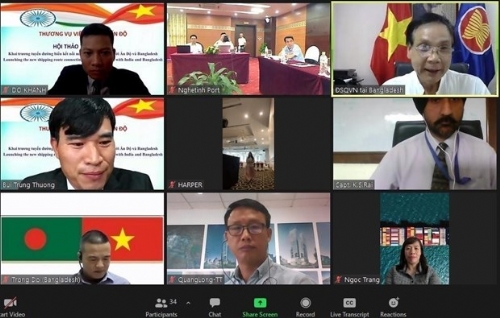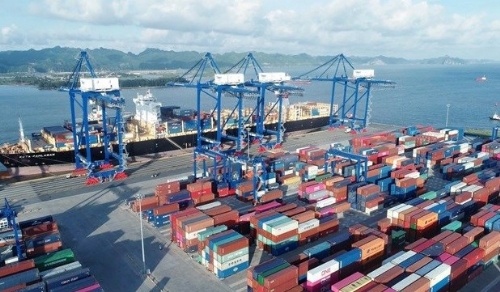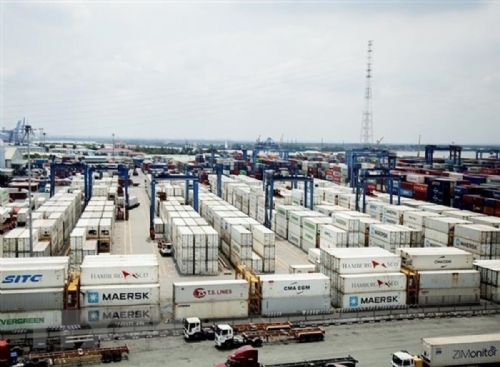Logistics, Forwarding and Warehousing Services
Monday, December 24, 2018 15:31

The strong development of international trade relations, trade demand and commodity boom has made logistics a very important service. Logistics services help improve management efficiency, reduce production costs and increase corporate competitiveness.
Overview of Vietnamese logistics market
Logistics services in Vietnam began to develop in the 1990s on the basis of freight forwarding services. Currently, the country has about 1,300 logistics services providers, covering freight forwarding, warehousing, loading and unloading, transport agency, forwarding agency and logistics services, mainly concentrated in Ho Chi Minh City and Hanoi.
Logistics services sectors in Vietnam may be classified as follows:
- Transport operators: transport services (road, sea, air, etc.).
- Infrastructure operators (ports, airports, railway stations, etc.)
- Operators of warehouses, stevedoring services and logistics services
- Freight forwarders, 3PL enterprises and other firms engaged in logistics software solutions, consultancy, superintendence, inspection and finance, among others.
According to Vietnam Logistics Business Association (VLA), the logistics industry in Vietnam has grown 14-16 per cent annually in recent years to US$40-42 billion a year.
Logistics value chains in Vietnam focus on forwarding, inland transportation, seaport and airport operation, warehousing, cargo handling and international transportation.
According to the World Bank's "Connecting to Compete 2016" Report: Trade Logistics in the Global Economy, Vietnam ranked 64th out of 160 countries in logistics development and fourth in ASEAN after Singapore, Malaysia and Thailand. Vietnamese logistics firms are mostly small and medium-sized, capable of handling only logistics, warehouse leasing, customs procedure and retail consolidation services, not involved in logistics chains as FDI firms.
Warehousing services: Warehousing in Vietnam can be divided into two main segments: Dry storage and cold storage. Some current companies are strong in leasing and warehousing management such as BS Logistics, Sotrans, Transimex, Gemadept, U&I Logistics, Vinafco Draco Seaborne, BK Logistics, ALS and ITL.
Logistics services firms in Vietnam include first party logistics (1PL - companies providing non-outsourced transport and warehousing services on their own) or second-party logistics (2PL) (providing individual, not integrated, services). Third-party logistics (3PL) is not much and the value of 3PL contracts is very limited relative to its potential.
According to a report on 3PL integrated logistics market in Vietnam by Armstrong & Associates, 3PL revenue to logistics service revenue is relatively small compared to that of other countries (around 0.8 per cent of the GDP) although logistics costs account for more than 20 per cent of GDP.
Forwarding services: Freight forwarding has grown steadily since Vietnam initiated open-door policies and signed free trade agreements. Traditional delivery consists of two parts: (i) container forwarding typically supplied by GMD, HMH and STG and (ii) container freight station (CFS) service or consolidation service mainly catered by foreign companies. Domestic warehouse leasers include TBS, Tan Cang Song Than, and Tan Cang Long Binh.
In addition, the robust e-commerce development in Vietnam (expected to reach US$10 billion by 2022) is resulting in greater demand for goods delivery in the domestic market. Businesses/shippers also have more choices in selecting forwarding partners, with such big names as Viettel Post, VNPost, Saigon Post, Giaohangnhanh, Shipchung and Giaohangtietkiem. In addition to conventional delivery service providers, many are adopting advanced technology to launch fast delivery services like Grab, Uber and Ship, etc.
Logistics business allocation: Ho Chi Minh City has most logistics enterprises (54 per cent of the total), followed by Hanoi (18 per cent). Haiphong is ranked third because it has a relatively developed seaport system and a well-connected traffic connection to the entire northern region.
2017 marked significant progress towards completing the legal framework and policies in connection with logistics. The Prime Minister signed Decision 200/QD-TTg approving the Action Plan for enhancing the competitiveness and development of logistics services in Vietnam.
According to the decision, the share of logistics services to the nation’s GDP is 8 - 10 per cent; the logistics service sector will grow 15 - 20 per cent a year; logistics costs will fall to 16 - 20 per cent of the GDP; Vietnam is ranked 50 or higher in Global Logistics Performance Index. The decision is considered to be quite comprehensive and detailed and serves as a foundation for improving logistics performance in Vietnam in the coming years.
Logistics as a driving force for export
Logistics has become an important service sector of international trade and attracted the special attention of the economic community.
Accordingly, logistics services help improve management efficiency, reduce production costs and increase corporate competitiveness. They also help reduce distribution costs.
Logistics allows enterprises to effectively tackle inputs and outputs, optimise the process of transporting materials, goods and services, while reducing costs and enhancing corporate competitiveness.
Logistics development allows expanding international trade. In addition, electronic logistics development will result in a revolution in transport and logistics services. The higher quality of logistics services will further narrow the space and time. Countries will get closer together in production and distribution.
Vietnam's export-import market is very robust, with the trade value exceeding US$400 billion in 2017. The value will continue to go up in the coming years. Therefore, if the quality of logistics is improved, it will be a big boost to the export sector of Vietnam.
However, common weaknesses of logistics companies in Vietnam are non-competitive service costs and low service quality. This comes mainly from scale, finance, experience, governance, information technology and human resources of enterprises. In fact, many Vietnamese exporters and importers are doing logistics services for their own goods, e.g. transportation, which will increase business costs.
To develop logistics and boost exports, in the coming time, Vietnam needs to improve policies, increase investment for logistics infrastructure, strengthen cooperation with foreign partners to expand logistics infrastructure to connect Vietnam's ports with neighbouring countries.
Other news
- Shipping route connecting central Vietnam, India inaugurated(7/29/2022 11:22:05 AM)
- List of seaports of third-class and higher announced(7/18/2022 11:17:01 AM)
- HCM City approves 50% port infrastructure fee cut(7/12/2022 1:59:05 PM)
- Cai Mep port ranked 11th among the world’s most efficient container ports(6/13/2022 3:21:56 PM)
- Cargo throughput via seaports sees modest growth(5/25/2022 1:55:23 PM)
- USAID helps ease congestion at Cat Lai container port(5/23/2022 2:46:53 PM)
- Cua Lo Port receives first international container ship(5/6/2022 11:02:29 AM)
- Cargo through seaports rises 3 percent in four months(5/4/2022 10:40:35 AM)
- Vietnam seeks ways to boost logistics industry(5/4/2022 10:37:17 AM)
- Vietnam's logistics must keep up with international standards(4/26/2022 11:40:15 AM)





